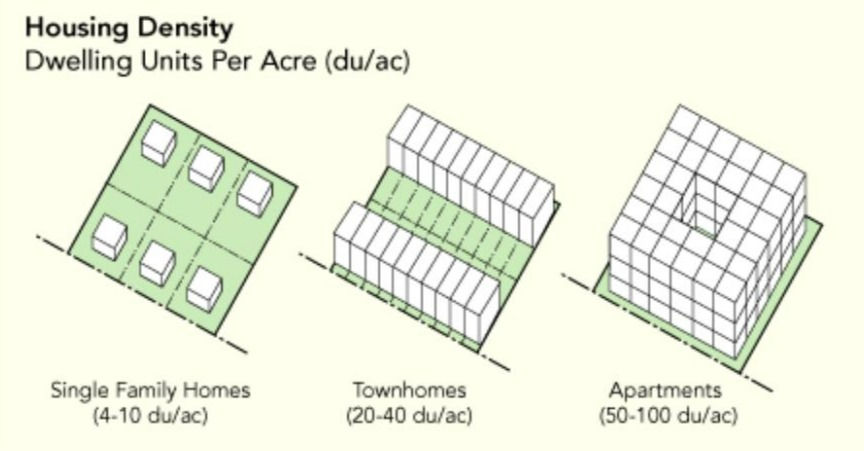People often want to know how many dwelling units can be built on a piece of land.
This is an important element of building regulations, but finding and calculating this aspect of the zoning can be complicated. Let's get started.


Finding the regulations
Here's how you can find this information, and how UrbanForm can help those who need to know this information quickly and cheaply.
Is it a permitted use?
The first thing you need to do is check whether the type of dwelling unit you are looking to build is a permissible use. This can be done by doing your zoning research; either manually by yourself or by using UrbanForm.
If you'd like to do it manually, UrbanForm provides guides on how to undertake all the steps necessary to source, gather, and document zoning information. Those guides are here.
Multi-unit building uses are typically gathered in the 'Residential' categories, though you will also need to check the 'Commercial' use categories as well, as many jurisdictions classify apartments, condos, or other multi-family/unit building types as commercial.
If you are using UrbanForm, just click on the "Use Regulations" button to confirm whether or not what you're looking to build is allowable.

Search for Unit or Density regulations
If the use you are interested in is allowable, the second thing you need to do is check whether or not there are any Unit Minimum or Unit Maximum regulations.
If you are researching your zoning manually, find the specific sections in the zoning text that refer to "unit minimums," "unit maximums," "unit density," and "development standards," as well as any overlays or location specifics that may modify those regulations. Be sure to search for any bonuses or restrictions that may be available, and read those guidelines to understand if they modify the use or unit regulations.
If you are using UrbanForm, just click on "Residential units" We show you the rules, calculate the results, show all available bonuses, and provide links for you to verify and learn more.

Calculating the formulas
If you are using UrbanForm, you can skip this step.
Because unit minimums, maximums, and other regulations are often given in the form of a formula, the next step is to calculate the formulas. These formulas are often dependent on site characteristics (e.g., 17 dwelling units/acre; 1000 square feet of lot area per 1 bedroom unit).
If you are doing your zoning information manually, gather all of the information necessary in the formula, such as lot area. Formulas may require other specifics, such as adjacencies to specific zones, overlays, locations on certain streets, lot orientation (corner, interior, thru, flag, etc.), or other. Then calculate the formulas as necessary.
Be sure to look up the specific guidelines specific to each jurisdiction as to how to round numbers, because many cities have specific rules as to how to round decimals for units (for instance, some regulations specify that you always round up to the nearest unit, some others specify different kinds of rules). Look in the zoning code for any sections called something like: "Measurements." After reading carefully and doing the calculations as prescribed, you should arrive at an allowable minimum and maximum number of units for that particular property.
If you are using UrbanForm, the "Unit Minimums" and "Unit Maximums" tab already has done the calculations for you including following the specific guidelines for calculating, if any.
UrbanForm helpfully has provided in the comments the formulas and calculations and a link for you to verify and/or do further research.
Understanding unit mix
Often, in large multi-family or multi-unit buildings in certain locations, there are specific types and sizes of units that make sense. For instance, studio, 1-bedroom apartments or 2-bedroom apartments, between 900 and 1,400 square feet.
Here's how to understand if a certain unit mix will work well on a property.
First, calculate the maximum buildable area
If you are gathering your zoning information manually, you will need to figure out the maximum buildable area for this property. This is a complicated procedure, and may require some drafting and area calculations. You will need to understand coverage limits, setbacks, height limits, floor-area-ratios, and typical floor-to-floor heights for specific types of buildings.
If you are doing this work manually, it may be worth considering hiring an architect for some initial guidance in determining the maximum buildable area. For a glimpse into how UrbanForm calculates this, see this post here.
If you are using UrbanForm, just click on MaxBuild. We've done all of these calculations to be able to tell you what the maximum buildable area is, both as-of-right (AOR) and with all-bonuses-taken (ABT).

Test some unit scenarios
Once you have understood the maximum buildable area (MaxBuild in UrbanForm), and the unit minimums and maximums, you can then start to see what some basic rough unit mixes may result in for this building.
For instance, if a site allows a maximum buildable area of 10,000 square feet and a maximum unit density of 10, that would result in 1,000 square feet per unit.
That may or may not be a feasible development scenario.
That is why this calculation is important to understand as quickly as possible.
You can then adjust the number of units and/or size of the building (all within the allowable numbers) until you reach something that fits within your design and development parameters, as well as within the allowable zoning.
UrbanForm has helpfully provided a Unit Calculator, that allows you to adjust number of units, size of building, FAR, and bonuses taken so that you can see these results dynamically--in real time.

Conclusion
Understanding how many units can be built on a site is not an easy task. It's not just finding the applicable regulations, but then understanding within those regulations what makes sense from a design and development standpoint.
UrbanForm provides tools for you to quickly understand both the regulations that apply as well as test certain basic scenarios.

Comments